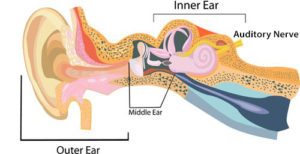Hearing loss is defined when your ability to hear in everyday situations is reduced and it has become more difficult for you to hear speech and other sounds. A trained professional can test your hearing using a variety of tests and record those results on an audiogram and can assess the level of hearing loss, as well as recommend and prescribe solutions. Hearing loss can be categorized as mild, moderate, severe, or profound. A hearing loss can occur in one ear only (single-sided hearing loss) or in both ears (bilateral hearing loss). You can be born with a hearing loss, or lose your hearing over time, or you can have a sudden hearing loss.
There are four types of hearing loss:
1. Sensorineural hearing loss (SNHL) which results from missing or damaged sensory cells (tiny hair cells) in the inner ear or cochlea. Problems with the nerve pathways from your inner ear to your brain can also cause SNHL. This is the most common type of hearing loss. Soft high pitched consonants and environmental sounds may be hard to hear. The patient cannot understand speech clearly. The patient experiences a loss in volume. Noise-induced hearing loss is a permanent hearing loss caused by prolonged exposure to high levels of noise and is a form of SNHL. Presbyacusis or age related hearing loss is also a type of SNHL.
Sudden sensorineural hearing loss (SSHL), presumed to be of viral origin, is an otologic (ear) emergency that is medically treated with corticosteroids. See your doctor and get a referral to an ENT as soon as possible.
Some other causes of sensorineural hearing loss include:
- Viral or bacterial infections
- Certain prescription medications
- Ménière’s Disease
- Acoustic Neuroma a tumour which is located between the ear and the brain
- Hereditary factors
- This type of hearing loss is generally permanent.
2. Conductive Hearing Loss:
A conductive hearing loss happens when sounds cannot properly get through the outer and middle ear to the inner ear. It may be hard to hear soft sounds. Louder sounds may be muffled. It can be temporary if caused by too much ear wax or an ear infection.
Other causes include:
- Fluid build-up
- A punctured eardrum
- Foreign objects in the ear canal
- Dislocation of the ossicles (3 middle-ear bones)
- Otosclerosis (disease of the middle ear)
- Unusual bone growths
- Tumours
This type of hearing loss can sometimes be treated with medicine or surgery.
3. Mixed.
Sometimes, a conductive hearing loss happens at the same time as a sensorineural hearing loss. This means that there may be damage in the outer or middle ear and in the inner ear or nerve pathway to the brain. This is a mixed hearing loss. The sensorineural hearing loss is generally permanent, but in some cases the conductive hearing loss can be treated medically.
4. Auditory Processing Disorders, Auditory Neuropathy Spectrum Disorder or Neural Hearing Loss:
Hearing loss that occurs when sound enters the ear normally, but because of damage to the inner ear or the hearing nerve, sound isn’t organized in a way that the brain can understand When the auditory nerve is damaged or missing, this is known as a neural hearing loss. Hearing aids and cochlear implants cannot help because the nerve is not able to pass on sound information to the brain. In many cases, however, an Auditory Brainstem Implant (ABI) may be an option.
